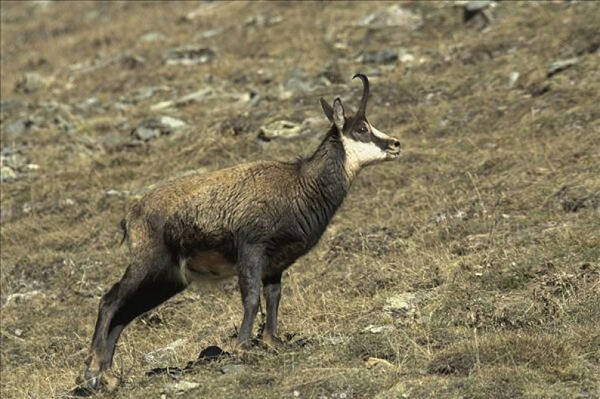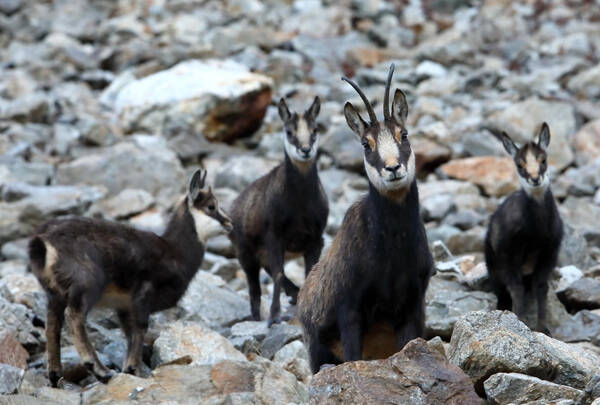Rupicapra rupicapra
IUCN
LCBasic Information
Scientific classification
- name:Rupicapra rupicapra
- Scientific Name:Rupicapra rupicapra
- Outline:Ungulata
- Family:Artiodactyla Bovidae Antelope
Vital signs
- length:110-135cm
- Weight:25-50kg
- lifetime:14-22years
Feature
There is a distinct black stripe under the eye and a black ridge down the back.
Distribution and Habitat
Origin: Albania, Austria, Azerbaijan, Bosnia and Herzegovina, Bulgaria, Croatia, France, Georgia, Germany, Greece, Italy, Montenegro, North Macedonia, Poland, Romania, Russia, Serbia, Slovakia, Slovenia, Switzerland and Turkey.
Introduced: Czech Republic and New Zealand.
The chamois inhabits steep rocky areas, mainly in mountainous areas, living in alpine and subalpine meadows above the tree line, including open rocky areas, mixed broadleaf woodlands and coniferous woodlands. Winters in forested areas without snow and on steep slopes. Can also be found in relatively steep and flat terrain.
Appearance
The chamois weighs 25-50 kg; the shoulder height is 70-80 cm and the body length is 110-135 cm. The fur is chestnut, but the color is lighter in spring and summer. In winter, these animals grow long guard hairs under the dark brown fur. The underparts of the body are pale, with white on the rump and tail. A dark brown band extends from each side of the muzzle to the ears and eyes, and the rest of the head and throat are white. There is a black ridge on the back. The male's horns extend directly above the head and then curve sharply back at the tip. Females also have horns, although they are thinner than those of males, but can be longer. Females are smaller than males. The chamois' hooves are well suited for gripping smooth rocks.
Details
Rupicapra rupicapra (scientific name: Rupicapra rupicapra) English Northern Chamois, Alpine Chamois, Anatolian Chamois, Asia Minor Chamois, Balkan Chamois, Carpathian Chamois, Caucasus Chamois, Chamois, Tatra Chamois, Turkish Chamois, French Chamois, Spanish Gamuza, Gamuza Septentrional, Rebeco septentrional, German (Alpen-) Gämse, there are 7 subspecies.

The ibex is primarily a diurnal animal. As a mountainous species, the ibex has adapted to rocky mountainous areas. Their climbing ability is second only to that of ibexes. Females and young males live in groups, while adult males are solitary and aggressive during the rutting season. These breeding males drive young males out of the herd, sometimes killing them. The species announces danger with whistles and stamping feet, and when frightened, these animals flee to the most inaccessible places, often making amazing leaps, can jump nearly 2 meters high and leap up to 6 meters, and can run at speeds of 50 kilometers per hour on uneven ground.
During the summer months, the diet of the antelope is mainly herbs and flowers, but in winter, the antelope eats lichens, mosses and pine shoots. They can even fast for two weeks and survive when the snow is so deep that no food can be found.

Male antelopes are generally solitary except during the breeding season. They join the herd in late summer. Older males will force younger males to leave the herd, sometimes even killing them. Reproduction is likely to be polygamous. Mating occurs between late October and December, with a gestation period of 170 days, and lambs are born in May-June, in places that provide shelter, such as grass and lichens. Females usually give birth to only one child, but sometimes twins and triplets occur. The young weigh 2-3 kg and are nursed for 2-3 months. Precocious lambs can follow their mother almost immediately after birth and rapidly improve their jumping ability in the first few days of life. If the mother is killed, other antelopes will take care of the young. Young males stay with the maternal group until 2-3 years old, then leave the group to live a nomadic life until they are fully mature at 8-9 years old, when they become attached to a specific area. Females reach sexual maturity at 2.5 years old, and males at 3.5-4 years old. Lifespan is 14-22 years.
The chamois as a species is widely distributed, with a population of nearly 500,000 individuals. Although some parts of its distribution range are declining, most of the population (the nominate subspecies R. r. rupicapra) lives in the Alps and the population is safe. Therefore, the species is assessed as Least Concern. However, most subspecies of the antelope are threatened and require urgent conservation action.
Listed in the IUCN Red List of Threatened Species in 2020 ver3.1 - Least Concern (LC).
Protect wildlife and eliminate game.
Maintaining ecological balance is everyone's responsibility!








